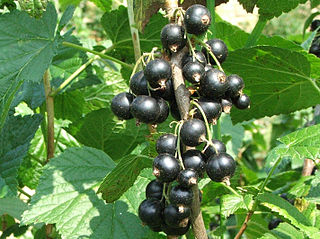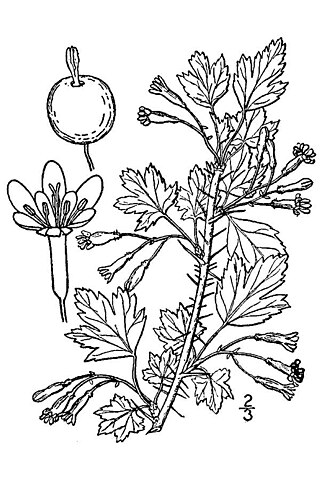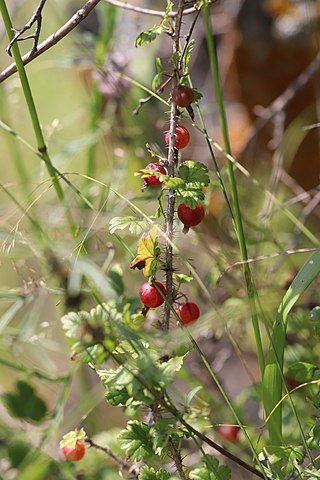
Rusts are plant diseases caused by pathogenic fungi of the order Pucciniales.

Ribena is a brand of blackcurrant-based soft drink, and fruit drink concentrate designed to be mixed with water. It is available in bottles, cans and multi-packs. Originally of British origin, it was produced by British pharmaceutical company GlaxoSmithKline (GSK) until 2013, when the brand was sold to Japanese beverage conglomerate Suntory.

Gooseberry is a common name for many species of Ribes, as well as a large number of plants of similar appearance. The berries of those in the genus Ribes are edible and may be green, orange, red, purple, yellow, white, or black.

The blackcurrant, also known as black currant or cassis, is a deciduous shrub in the family Grossulariaceae grown for its edible berries. It is native to temperate parts of central and northern Europe and northern Asia, where it prefers damp fertile soils. It is widely cultivated both commercially and domestically.

Zante currants, Corinth raisins, Corinthian raisins or outside the United States simply currants, are raisins of the small, sweet, seedless grape cultivar Black Corinth. The name comes from the Anglo-French phrase "raisins de Corinthe" and the Ionian island of Zakynthos (Zante), which was once the major producer and exporter. It is not related to black, red or white currants, which are berries of shrubs in the genus Ribes and not usually prepared in dried form.

Ribes is a genus of about 200 known species of flowering plants, most of them native to the temperate regions of the Northern Hemisphere. The various species are known as currants or gooseberries, and some are cultivated for their edible fruit or as ornamental plants. Ribes is the only genus in the family Grossulariaceae.

Pinus strobus, commonly called the eastern white pine, northern white pine, white pine, Weymouth pine (British), and soft pine is a large pine native to eastern North America. It occurs from Newfoundland, Canada, west through the Great Lakes region to southeastern Manitoba and Minnesota, United States, and south along the Appalachian Mountains and upper Piedmont to northernmost Georgia and perhaps very rarely in some of the higher elevations in northeastern Alabama. It is considered rare in Indiana.

The redcurrant or red currant is a member of the genus Ribes in the gooseberry family. It is native to western Europe. The species is widely cultivated and has escaped into the wild in many regions.

Cronartium ribicola is a species of rust fungus in the family Cronartiaceae that causes the disease white pine blister rust. Other names include: Rouille vésiculeuse du pin blanc pin (French), white pine Blasenrost (German), moho ampolla del pino blanco (Spanish).

Ribes sanguineum, the flowering currant, redflower currant, red-flowering currant, or red currant is a North American species of flowering plant in the family Grossulariaceae, native to the western United States and Canada.

Cecidophyopsis ribis is an eriophyid mite which is best known for being a plant parasite, a pest of Ribes species, the genus that includes gooseberries and blackcurrants. It is commonly known as the blackcurrant gall mite or big bud mite. It feeds on the plants' buds, forming galls, and transmits a virus which causes blackcurrant reversion disease. The mite is a serious pest of blackcurrant crops in Europe, but rarely on other continents.
Greg Quinn is an American farmer in Staatsburg, New York, who lobbied several NY state senators and assemblypersons and in 2003, was successful in overturning the ban on the commercial cultivation of blackcurrants, enacted by Congress in 1911. blackcurrants, a berry fruit used in juice, jams, candy, yogurt, ice cream, and cereal provide twice the antioxidant ORAC capacity per serving of blueberries, four times the vitamin C content of oranges, and twice the potassium content of bananas. With no supply and no market, Quinn founded his company, CurrantC™, in 2003 and began to grow black currants on his 135-acre (55 ha), farm and Quinn sought to interest consumers and New York farmers in the fruit, which was then being supplied to the United States by Europe usually in the form of preserves. CurrantC™ is now the number one supplier of Currant products in the United States. In addition to farming and teaching at the New York Botanical Garden, Quinn has written eight children's books published by Scholastic Press, including the titles A Gift of a Tree, The Garden in Our Yard, 365 Meditations for Teachers, and books within the Natural Treasure series. He also has written for SKY magazine, Good Housekeeping, and Fine Gardening and has been "The Garden and Nature Guy" on WHUD and other Pamal Broadcasting radio stations, and FOX 5 television, WNYW out of New York City.

The jostaberry is a complex-cross fruit bush in the genus Ribes, involving three original species, the blackcurrant R. nigrum, the North American coastal black gooseberry R. divaricatum, and the European gooseberry R. uva-crispa. It is similar to Ribes × culverwellii, the jochelbeere, which is descended from just two of these species, R. nigrum and R. uva-crispa.

Ribes aureum, known by the common names golden currant, clove currant, pruterberry and buffalo currant, is a species of flowering plant in the genus Ribes native to North America.

Ribes missouriense, the Missouri gooseberry, Missouri currant or wild gooseberry, is a prickly, many-stemmed shrub native to the north-central United States. Scattered populations have been found farther east, most of them very likely escapes from cultivation.

The white currant or whitecurrant is a group of cultivars of the red currant, a species of flowering plant in the family Grossulariaceae, native to Europe.

Ribes americanum is a North American species of flowering plant in the gooseberry family known as wild black currant, American black currant, and eastern black currant. It is widespread in much of Canada and the northern United States.

Ribes oxyacanthoides is a species of flowering plant in the gooseberry family known by the common name Canadian gooseberry. Its various subspecies have common names of their own. It is native to North America, where it occurs in Alaska through much of Canada and the western and north-central United States.

Ribes aciculare is a species of flowering plant in the currant/gooseberry family Grossulariacea, generally regarded as closely related to Ribes burejense. It is native to central and northern Asia, and has been reported as native to Altay, Kazakhstan, Krasnoyarsk, Mongolia, Tuva, West Siberia, Xinjiang. Its habitats vary from stony hill and mountain slopes to forest margins and thickets. In Northern China it has been found at altitudes of 1,500-2,100 metres. The plant is very cold hardy, and can tolerate temperatures down to -20°C during dormancy.

Cryptomyzus ribis is a species of true bug found in Europe and described by the Swedish taxonomist, Carl Linnaeus in 1758. The larvae feed on the leaves of currant bushes, especially red currant, creating abnormal plant growths, known as galls.
























